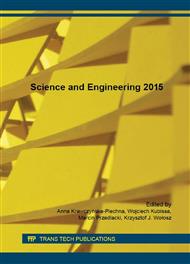p.246
p.255
p.263
p.274
p.282
p.290
p.299
p.307
p.314
Vibration Transmission Loss of Auxetic Lattices
Abstract:
The auxetic lattices are structures, which have the negative Poisson’s ratio. When material has negative Poisson’s ratio, has also auxetic properties - during process of stretching, are made wider and during compressing are made narrower. This structures are cellular and negative Poisson’s ratio is depending on the geometry of single auxetic cell. When geometry of the cell is slightly changed also Poisson’s ratio is different. Auxetics have attracted attention of researchers because of their superior dynamic properties. The lattice auxetic structures at one of their natural frequencies exhibit the deformed geometry. It’s can be exploit as resonance to optimization of the power required for the occurrence localized deformations. The dynamic behavior of auxetic and their transmission of the vibration, which is circumscribed by the parameter VTL (Vibration Transmission Loss) will be analyzed in this article.
Info:
Periodical:
Pages:
282-289
Citation:
Online since:
November 2015
Authors:
Keywords:
Price:
Сopyright:
© 2015 Trans Tech Publications Ltd. All Rights Reserved
Share:
Citation:


